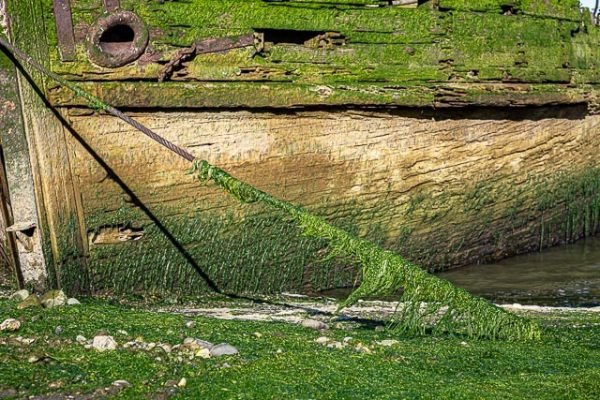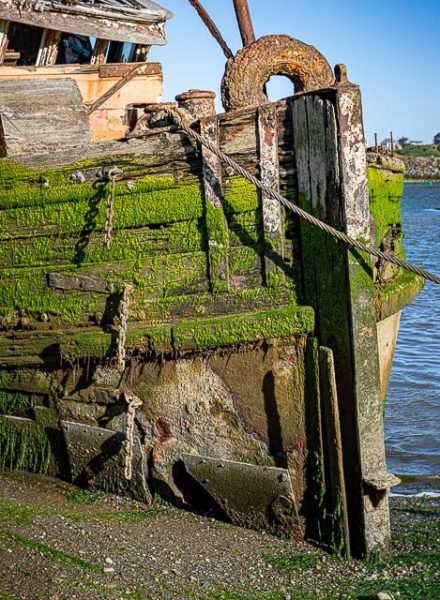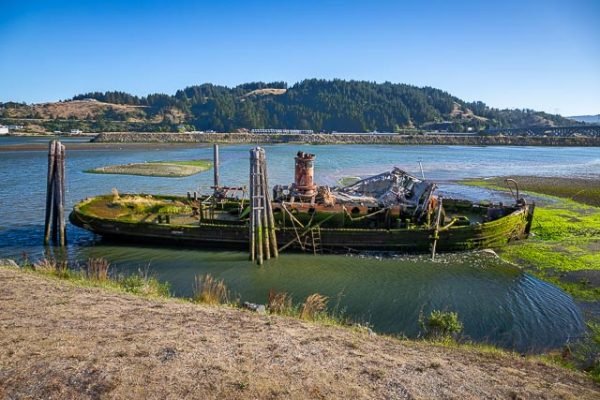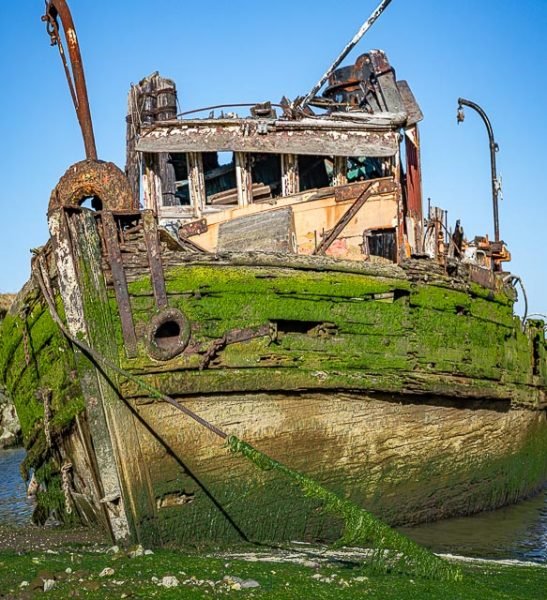Mary D Hume Shipwreck

In 1876, R. D. Hume of Astoria, Oregon, relocated his salmon fishing, processing and shipping business to the mouth of the Rogue River to take advantage of the annual spawning migration of king salmon from the Pacific to their birthplace in the river.
Four years later, when his small steamer Varuna was destroyed on a bar in the river, Hume salvaged the steam engine. He located a 141 foot white cedar thirteen miles upriver and had it felled and floated downriver to a location less than two hundred feet from where the Mary D. Humenow rests. The trunk of the cedar was used to build the keel and the curved cedar roots were used for ribs. Myrtlewood dowels joined the ribs to the keel.
The vessel, named Mary Duncan Hume after the owner’s wife, was launched on 21 January 1881 to begin ninety-seven years of active commercial sea service, the longest for any commercial vessel on the west coast.
She spent her first ten years as a coastal freighter hauling wood, canned salmon and other cargo from Oregon to San Francisco. In late 1899, she was sold to the Pacific Whaling Company for $25,000 and steamed north to the Bering Sea for a decade as an arctic whaling vessel. Her most notable expedition lasted six years, the lengthiest recorded arctic whaling voyage. After surviving a severe storm in 1899, she settled down to towing service in Alaska’s Nushagak River.
In 1909,The American Tug Boat Company purchase her and configured her as an ocean tugboat. Except for a brief stint in the Alaska halibut industry, she remained an ocean tugboat until she retired in 1978 and, like countless salmon and steelhead before her, returned from the open ocean to the river where she was born.
The Hume was listed on the National Register of Historic Places on August 1, 1979, when she was afloat and berthed on the Rogue River. Repairs started in 1985, but an accident led to her sinking. Efforts were made to survey and raise her, but there were no funds to make the effort. In 1992 the Hume’s status on the National Register was reviewed. The review concluded that her hull still held significance and she was retained on the National Register.
Although Mary D. Hume is on the National Register of Historic Places, she is not maintained and she is slowly breaking apart and sliding into the Gold Beach muddy waters.
What to Photograph
The decaying ruins of the Mary D Hume Steamer resting on the bottom of the Rouge River. At low tide you can walk around the wreckage and shoot most of the hull from a variety of angles, while at high tide the hull is mostly submerged.
Where it is:
29980 Harbor Way, Gold Beach, OR 97444
From Gold Beach, Oregon head North on Highway 101. Turn left onto Harbor Way. You will see the wreck in the water very close to the road.
Maps:
Interactive Google Map
Use the map + – controls to zoom in and out, click and drag the to move the map, use the Map drop-down to change to “Map”, “Satellite”, “Hybrid”, or “Terrain” views. Drag the little man icon from the upper left corner to a map location for street level view.
GPS:
42°25’20.248″ N 124°25’2.2″ W
Hours:
The location is open 24 hours a day.
Cost:
There is no cost to visit this location.
Location Contact Information:
There is no contact for the location.
Official Website of Gold Beach, Oregon
City Hall 29592 Ellensburg Ave. Gold Beach, OR 97444
P: (541) 247-7029 F: (541) 247-2212
Open 8 a.m. to 5 p.m., Monday – Friday
Mary D Hume Shipwreck Photo Gallery
Click Here for full page gallery
More Photographic Destinations in Oregon:
Interactive Google Map
Use the map + – controls to zoom in and out, use the Map drop-down to change to “Map”, “Satellite”, “Hybrid”, or “Terrain” views. Drag the little man icon from the upper left corner to a map location for street level view. Click on a pushpin for more information about the Photographic Destination, then click on the title to go to the location page.
Click Here for Photographic Destinations by State








Hello,
This was my grandfather’s tug while he was working in Everett, Washington. Frank Frederick Watts.
Shared the images with my mom who is currently living in Snohomish and has many stories of the tug.
Thank you for sharing.
Kindly,
Megan Stilwell
Greg: Thank you for the excellent images to accompany a wonderful story!